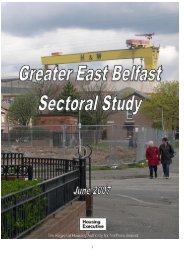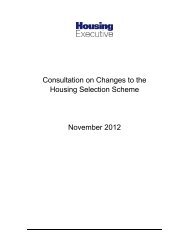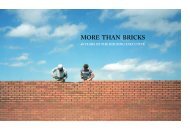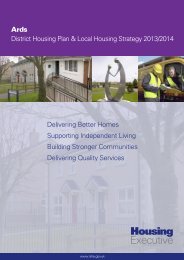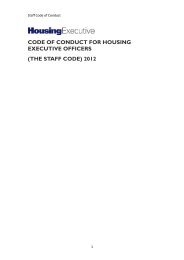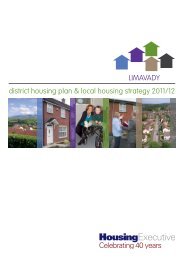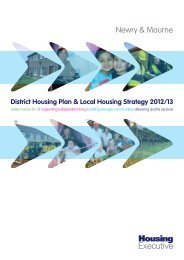Home From Home - Northern Ireland Housing Executive
Home From Home - Northern Ireland Housing Executive
Home From Home - Northern Ireland Housing Executive
You also want an ePaper? Increase the reach of your titles
YUMPU automatically turns print PDFs into web optimized ePapers that Google loves.
<strong>Home</strong> from <strong>Home</strong><br />
Older Chinese People<br />
HOUSING NEEDS ASSESSMENT<br />
NORTH WEST AREA
Acknowledgements<br />
The <strong>Housing</strong> <strong>Executive</strong>’s Research Unit would like to thank all those involved in the<br />
Older Chinese People <strong>Housing</strong> Needs Assessment, in particular the following:<br />
the Chinese Community who gave up their time to assist the interviewers and<br />
without whose co-operation the survey could not have been undertaken.<br />
Anna Lo (CWA), Karen Scrivens (Sai Pak Project, Derry) Brendan Bonner<br />
(Western Investing for Health) and Brendan Adams (NIHE) for their input<br />
into the questionnaire and their support for the aims of the survey.<br />
For further information on the research please contact:<br />
Gillian Greer<br />
Research Officer<br />
The Research Unit<br />
NI <strong>Housing</strong> <strong>Executive</strong><br />
2 Adelaide Street<br />
Belfast BT2 8PB<br />
Telephone: 028 90318553<br />
Email: gillian.greer@nihe.gov.uk
<strong>Home</strong> from <strong>Home</strong><br />
Older Chinese People<br />
HOUSING NEEDS ASSESSMENT<br />
NORTH WEST AREA<br />
1
'The Chinese Welfare<br />
Association will work to<br />
enhance diversity<br />
and good relations in <strong>Northern</strong><br />
<strong>Ireland</strong> and to develop the<br />
participation of Chinese people<br />
in all aspects of social, cultural,<br />
economic and public life.'<br />
2<br />
(Mission Statement, CWA)
Contents<br />
Foreword 4<br />
1. Background to the research 5<br />
1.1 Introduction 5<br />
1.2 The Chinese Welfare Association (CWA) 6<br />
1.3 Rationale 6<br />
1.4 Research Objectives 7<br />
1.5 Methodology 7<br />
1.6 Response Rate 9<br />
2. <strong>Executive</strong> Summary 11<br />
3. Household Profile 17<br />
4. Current Accommodation 25<br />
5. Community Safety 29<br />
6. Older Respondents (50+) 31<br />
7. Conclusions And Recommendations 41<br />
8. Location Of Respondents 45<br />
Appendices<br />
Appendix 1: presentation of findings 47<br />
Appendix 2: tabular report 49<br />
3
Foreword<br />
It gives me great pleasure to write the foreword for this<br />
report.<br />
I recall the many barriers we experienced when the Chinese<br />
Welfare Association (CWA) lobbied for the first ever sheltered<br />
housing scheme for a minority ethnic community some ten<br />
years ago. It was so different this time, which I believe reflects<br />
the growing diversity in <strong>Northern</strong> <strong>Ireland</strong>.<br />
I wish to commend the <strong>Northern</strong> <strong>Ireland</strong> <strong>Housing</strong> <strong>Executive</strong> (NIHE) for its swift<br />
and positive response to the request from the Chinese community in Derry/<br />
Londonderry to establish a scheme for supported housing by conducting<br />
this needs assessment. The partnership between the NIHE and the CWA, I<br />
hope, was enriching for both organisations. The fact that four local bilingual<br />
interviewers were trained and supported by the NIHE over the whole process<br />
of the research ensures that skills developed within the community will<br />
continue to benefit the community after the research is completed.<br />
The findings clearly demonstrated a demand for supported accommodation<br />
and I have no doubt that this scheme will be as successful as the one built in<br />
Belfast to benefit many older Chinese people and their families.<br />
Anna Lo, MBE, MLA<br />
4
1. Background to the Research<br />
1.1 Introduction<br />
The Chinese community is the largest settled minority ethnic group in<br />
<strong>Northern</strong> <strong>Ireland</strong> (approximately 8,000 people) 1 . Since the early 1960s,<br />
Chinese people have been settling in <strong>Northern</strong> <strong>Ireland</strong>, mostly from Hong<br />
Kong, but in recent years there have been significant numbers of new<br />
immigrants from mainland China, including documented workers, students,<br />
asylum seekers and illegal immigrants.<br />
In Derry/Londonderry and surrounding areas, there are 32 registered Chinese<br />
restaurants and takeaways. It is estimated that there are more than 1,000<br />
Chinese people living in the North West of the province.<br />
The settled Chinese population is into its second or even third generation.<br />
They have been born and brought up in <strong>Northern</strong> <strong>Ireland</strong>, are generally well<br />
integrated and work outside the Chinese community in different types of<br />
employment.<br />
The Chinese community has made significant economic and cultural<br />
contributions to <strong>Northern</strong> <strong>Ireland</strong>. However, the majority of first generation<br />
Chinese people (approximately 85%) do not speak English and consequently<br />
have difficulty accessing public information and services. The language<br />
difficulties also prevent many from integrating into the wider community,<br />
which can lead to social isolation. Some 95% of first generation Chinese<br />
people are engaged in the Chinese catering trade, working long and<br />
unsociable hours. Racism is also a problem experienced by many<br />
Chinese people.<br />
1<br />
www.cwa-ni.org<br />
5
1.2 The Chinese Welfare Association (CWA)<br />
The CWA, established in 1986, is the main support and representation<br />
organisation for the Chinese community in <strong>Northern</strong> <strong>Ireland</strong>. Its legal<br />
structure is that of a company limited by guarantee with charitable status.<br />
The CWA's mission statement is:<br />
'The Chinese Welfare Association will work to enhance diversity and good<br />
relations in <strong>Northern</strong> <strong>Ireland</strong> and to develop the participation of Chinese<br />
people in all aspects of social, cultural, economic and public life.'<br />
The CWA runs a range of projects in Belfast: dealing with community<br />
development, community relations, services for older people, youth clubs,<br />
after-school clubs, interpreting and translation services, welfare and<br />
immigration advice, health advocacy, information and communication<br />
technology (ICT) training and English for speakers of other languages<br />
(ESOL) teaching.<br />
Since January 2000, the CWA has been running the Sai Pak Chinese<br />
Community Project in Derry/Londonderry, promoting community capacity<br />
building and community relations as well as providing interpreting and<br />
advocacy services for Chinese people.<br />
1.3 Rationale<br />
Many first generation Chinese who came here in the 1960s have reached or<br />
are nearing retirement age. Some of them also brought their parents from<br />
Hong Kong to live with them in <strong>Northern</strong> <strong>Ireland</strong>. Due to language difficulties,<br />
many older Chinese people have experienced problems with moving into<br />
local supported housing schemes. There are several supported housing<br />
6
schemes in England and Wales for older Chinese people and in the 1990s a<br />
number of Chinese people left <strong>Northern</strong> <strong>Ireland</strong> to avail of these facilities. The<br />
CWA consequently carried out two pieces of research (1995, 1997), to identify<br />
the housing needs of older Chinese people in greater Belfast, and lobbied<br />
the <strong>Northern</strong> <strong>Ireland</strong> <strong>Housing</strong> <strong>Executive</strong> (NIHE). BIH <strong>Housing</strong> Association<br />
subsequently built a 41-unit sheltered housing scheme, Hong Ling Gardens,<br />
in McAuley Street in South Belfast.<br />
Hong Ling Gardens has been a success, with almost full occupancy within<br />
the first year. Recently the Sai Pak Project received enquiries from Chinese<br />
residents in Derry/Londonderry about the possibility of a similar scheme in<br />
the North West and CWA approached NIHE in respect of the local interest for<br />
supported accommodation. Subsequently, this study was co-funded by the<br />
<strong>Northern</strong> <strong>Ireland</strong> <strong>Housing</strong> <strong>Executive</strong> and Western Investing for Health.<br />
1.4 Research Objectives<br />
The main aim of the survey was to conduct a housing needs assessment<br />
of older Chinese people in the Greater Derry/Londonderry area. Findings<br />
will determine the housing, health and support needs of the older Chinese<br />
population and any social issues to be tackled. The survey will also provide<br />
a socio-economic profile and inform future planning of supported<br />
accommodation for older Chinese people in the Derry/Londonderry area.<br />
1.5 Methodology<br />
In June 2006, following a selection procedure carried out in conjunction with<br />
NIHE, the CWA appointed four trained bilingual interviewers to undertake the<br />
fieldwork for the Older Chinese People <strong>Housing</strong> Needs Assessment.<br />
7
BIH PIC<br />
Hong Ling Gardens, South Belfast.<br />
8
Due to the nature of the survey, the Research Unit decided that face-toface<br />
interviews were required to maximise the response rate. In view of the<br />
significance of the project, it was felt that the involvement of people with<br />
links to the Chinese Community in Derry/Londonderry was essential to<br />
enable access to and participation from this community.<br />
The questionnaire design, analysis and report writing were the responsibility<br />
of the <strong>Housing</strong> <strong>Executive</strong>'s Research Unit. The content of the questionnaire<br />
was agreed in consultation with the Chinese Welfare Association and Western<br />
Investing for Health. The bilingual interviewers carried out face-to-face<br />
structured interviews between July and September 2006.<br />
The CWA's Sai Pak Project used its current database of membership to<br />
identify households for interview; in addition the Research Unit used a<br />
'snowball 2 ' sampling technique to extend the CWA's known database.<br />
1.6 Response Rate<br />
In total, 100 Chinese households were identified. The interviewers<br />
subsequently carried out 91 face-to-face interviews in the North West.<br />
Of the 91 households surveyed, 34 included an older Chinese person<br />
(aged 50 or older).<br />
As a general rule, if an interview had not been achieved on the first visit to<br />
an address, the fieldworker made at least three further attempts to interview<br />
the household. These visits were made at varying times of the day and also<br />
in the evenings. If, at the end of the fieldwork period, the fieldworker had<br />
been unable to contact a household member, the address was recorded as a<br />
non-contact. The research team was unable to contact only five households<br />
in total and four households refused to take part in the survey.<br />
2<br />
Snowball sampling involves identifying respondents who are then asked to refer researchers to other respondents.<br />
9
10<br />
The Chinese community<br />
has made significant<br />
economic and cultural<br />
contributions to<br />
<strong>Northern</strong> <strong>Ireland</strong>.
2. <strong>Executive</strong> Summary<br />
2.1 Profile of Household/Household Reference Person (HRP) 3 :<br />
• The overwhelming majority (82%) of HRPs were male.<br />
• Almost two-fifths (35; 39%) of HRPs were aged between 25 and 39 and<br />
more than one-third (34; 37%) were aged 50 or older.<br />
• Three-quarters (75%) of all HRPs were married.<br />
• The most common household types 4 were small family (25%) and large<br />
adult (22%).<br />
• More than one-third (37%) of HRPs were working full-time and 36% were<br />
self-employed.<br />
• Most households (79%) contained one family unit.<br />
• More than one-third (92; 34%) of household members were aged<br />
between 25 and 39 and almost one-fifth (47; 18%) were aged 50 or older.<br />
• The majority (78%) of HRPs had been born in Hong Kong or China.<br />
• More than two-fifths (41%) of HRPs were educated to secondary level and<br />
more than one-third (34%) to primary level.<br />
• Almost half (47%) of HRPs spoke only a little English and one-third (33%)<br />
spoke English well.<br />
• More than one-third (34%) of HRPs could not read or write any English;<br />
the same proportion could read and write only a little English.<br />
• Seven per cent had a health problem/disability limiting day-to-day<br />
activities.<br />
3<br />
See Appendix 1 for the definition of the term Household Reference Person.<br />
4<br />
See Appendix 2 (Table 11) for the definition of household types.<br />
11
2.2 Current Accommodation<br />
• Half (50%) of respondents were owner-occupiers and almost one-quarter<br />
(24%) were private renters.<br />
• Almost three-quarters (74%) of respondents lived in houses.<br />
• Most respondents (71%) were very satisfied/satisfied with their current<br />
accommodation.<br />
2.3 Community Safety<br />
• Almost all respondents felt safe in their own home (99%) and walking<br />
around the area (97%) during the day.<br />
• In terms of crime that had occurred in the previous 12 months, 14% of<br />
respondents said their property had been vandalised and 11% said their<br />
car had been vandalised.<br />
2.4 Older Respondents (50+) - 34 respondents<br />
• Around two-fifths of older respondents (14) said they were in receipt of<br />
benefits. The main benefit received was Income Support (5 people).<br />
• Almost two-thirds of older respondents (22) said that they knew only a<br />
few people in their neighbourhood.<br />
• Half of older respondents (17) thought neighbours looked out for each<br />
other.<br />
• The majority of older respondents (28) attended activities organised by<br />
Sai Pak.<br />
13
• The majority of older respondents (up to 27) used their own car for dayto-day<br />
activities.<br />
• More than half of older respondents (20) said that they need help with<br />
interpretation or translation.<br />
• The majority of older respondents (25) said that they would ask family for<br />
help with day-to-day activities if they needed it.<br />
• Almost two-thirds of older respondents (21) said they would ask Sai Pak<br />
and over half (19) would ask friends for help with day-to-day activities if<br />
they needed it.<br />
• Almost three-quarters of older respondents (24) said they would like<br />
assistance in obtaining information or advice about services for older<br />
people.<br />
• Twenty-three older respondents said they would like assistance with<br />
home safety and security measures; the same number said they would<br />
like help with interpretation and translation.<br />
• The overwhelming majority of older respondents (32 out of 34) felt that<br />
home security was an important factor which might influence where<br />
they live in the future.<br />
• More than one-third of older respondents (13) expected to remain in<br />
their current accommodation for one year or more but less than five<br />
years.<br />
14
• Half of older respondents (17) saw themselves moving into supported<br />
accommodation in the future ; the same number (17) stated that it would<br />
be their preference to do so.<br />
• Around three-quarters of older respondents (26) said they would prefer<br />
to live in a bungalow.<br />
• Almost three-quarters of older respondents (25) said that if a supported<br />
accommodation scheme for older Chinese people was available in the<br />
Derry/Londonderry city area they would consider living there.<br />
15
16<br />
The majority (78%) of<br />
HRPs had been born<br />
in Hong Kong or China
3. Household Profile<br />
Household Reference Persons (HRPs)<br />
3.1 Gender and Age of HRP<br />
More than four-fifths of HRPs (75; 82%) were male and 16 (18%) were female<br />
(Table 1).<br />
Almost two-fifths (35; 39%) of HRPs were aged between 25 and 39; 34 (37%)<br />
were aged 50+ and 21 (23%) were aged between 40 and 49. Small numbers<br />
of HRPs were aged between 16 and 24 (
3.2 Employment Status of HRP<br />
More than one-third (34; 37%) of HRPs were working full-time and 33 (36%)<br />
were self-employed. Ten HRPs (11%) were retired and nine (10%) were<br />
working part-time. Fewer HRPs were looking after family/home (
3.6 Competency of HRPs in English<br />
Almost half of HRPs (43; 47%) spoke only a little English, one-third (30; 33%)<br />
spoke English well and 18 (20%) spoke no English (Table 7).<br />
More than one-third (31; 34%) of HRPs could not read or write any English;<br />
the same proportion (31; 34%) could read and write only a little English. The<br />
remainder (29; 32%) could read and write English well (Table 8).<br />
3.7 HRPs with health problem/disability<br />
Very few HRPs reported a health problem which limits day-to-day activities (5;<br />
6%) or a disability which limits day-to-day activities (
Small family represented the largest household type (23; 25%), followed by<br />
large adult (20; 22%) and two adult (17; 19%). Equal proportions (13; 14%)<br />
were large family and lone adult households. Fewer households were lone<br />
older (
3.10 Family Unit<br />
A family unit cannot span more than two consecutive generations (e.g. a<br />
young mother with child [family unit 2], living with her parents [family unit<br />
1]). Ninety-one households took part in the survey, and findings show that<br />
more than three-quarters of households (72; 79%) contained one family<br />
unit and almost one-quarter (19; 21%) contained more than one family unit<br />
(Table 12).<br />
3.11 Age of household members<br />
All respondents were asked how many people lived in their household and<br />
the age of each member. In total, respondents provided information on age<br />
for 268 household members. More than one-third (92; 34%) of household<br />
members were aged between 25 and 39 and 47 (18%) were aged 50 or older.<br />
More than one-tenth (42; 16%) of household members were aged between<br />
40 and 49, 39 (15%) were aged between six and fifteen and 36 (13%) were<br />
aged between 16 and 24. Fewer household members were aged five or<br />
younger (12; 4%) (Figure 3: Table 13).<br />
21
Figure 3: Age of Household Members<br />
<br />
<br />
<br />
<br />
<br />
<br />
<br />
<br />
<br />
<br />
22
24<br />
Almost three-quarters<br />
of respondents (71%)<br />
were satisfied with their current<br />
accommodation.
4.0 Current Accommodation<br />
4.1 Tenure<br />
Half of respondents (45; 50%) were owner-occupiers and almost onequarter<br />
(22; 24%) were private renters. Fifteen respondents (17%) lived in<br />
tied accommodation provided by their employer and six (7%) were <strong>Housing</strong><br />
<strong>Executive</strong> tenants.<br />
The remaining respondents (
4.2 Dwelling Type<br />
Almost three-quarters (67; 74%) of respondents lived in houses and 15 (17%)<br />
lived in flats/apartments; fewer respondents (9; 10%) lived in bungalows<br />
(Table 15).<br />
Equal proportions of respondents (30; 33%) lived in detached and mid-terrace<br />
properties. The remainder lived in flats/apartments (15; 17%), semi-detached<br />
(11; 12%) and end terrace properties (5; 6%) (Table 16).<br />
Most properties (76; 84%) had three bedrooms or more, 14 (15%) had two<br />
bedrooms and a small number (
28<br />
Around one in three<br />
respondents (29%) had<br />
experienced at least<br />
one crime.
5. Community Safety<br />
5.1 The majority of respondents reported that they felt safe:<br />
• at home during the day (90; 99%);<br />
• walking around the area during the day (88; 97%);<br />
• at home after dark (84; 92%); and<br />
• walking around the area after dark (80; 88%) (Table 20).<br />
5.2 Crime<br />
Respondents were asked if they, or other members of their household,<br />
had experienced specific crimes during the previous 12 months. Some<br />
respondents had experienced vandalism to property (13; 14%), vandalism to<br />
car (10; 11%), burglary (8; 9%) and racial harassment (5; 6%). Smaller numbers<br />
of respondents had received verbal threats (
30<br />
Half of older respondents<br />
(17) saw themselves moving into<br />
supported accommodation in<br />
the future.
6. Older Respondents (50+)<br />
6.1 Introduction<br />
Of the 91 households that participated in the survey, more than one-third<br />
(34; 37%) included a member aged 50 or older. The analysis in this chapter is<br />
based on these 34 households.<br />
The questionnaire included a section to be completed by either the<br />
household member who was aged 50 or older, or by another responsible<br />
member of the household who could speak on behalf of that person. For ease<br />
of reporting, and to avoid unnecessary over-complication of the text, the 34<br />
respondents are described as 'older respondents' throughout this chapter.<br />
6.2 Benefits received by older respondents<br />
There has always been a low uptake of benefits by the Chinese community<br />
who, in general, are either unaware of their entitlements or unwilling to<br />
access welfare benefits 5 . Findings from the survey show that, of the 34<br />
older respondents, around two-fifths (14) were receiving benefits. The main<br />
benefit received by older respondents was Income Support (5 people).<br />
Few respondents (
their GP or consultant and a small number (
6.6 Transport<br />
Respondents were asked to state the mode of transport they used for a<br />
number of activities. Twenty-six older respondents used their own car to go<br />
shopping and 21 used public transport. Eighteen respondents were collected<br />
by a friend or relative to go shopping and the same number also walked.<br />
Seventeen respondents used a taxi when they needed to go shopping and<br />
fewer respondents (
The majority of older respondents (25 out of 34) used their own car for<br />
socialising and visiting. Eighteen respondents used public transport and<br />
the same number were collected by a friend or relative. Fifteen respondents<br />
used a taxi for socialising and visiting and the same number walked. Fewer<br />
older respondents (
Most older respondents (29) said they had never experienced any lack<br />
of opportunity for regular health check-ups; five older respondents had<br />
experienced problems occasionally in accessing regular health check-ups<br />
(Table 28).<br />
Almost three-quarters of older respondents (25) said they had never<br />
experienced any lack of activities for older members of the household<br />
who felt isolated and bored; five respondents had experienced problems<br />
occasionally and a small number (
In order to live safely and comfortably in their home, almost three-quarters of<br />
older respondents (24) said they would like assistance obtaining information<br />
or advice about services for older people. Equal numbers of respondents<br />
(23) said they would like assistance with home safety/security measures and<br />
help with translation/interpretation. Almost two-thirds of respondents (22)<br />
would like assistance filling in forms, 17 respondents would like help with<br />
decorating, 14 respondents would like assistance with welfare adaptations<br />
and 14 with gardening. More than one-third of respondents (13) stated they<br />
would like help with housework (Table 33).<br />
6.8 Future housing needs<br />
Older respondents were asked to consider how important a number<br />
of factors would be in influencing where they live in the future. The<br />
overwhelming majority (32 out of 34 respondents) felt home security was<br />
important and over four-fifths (28 respondents) felt it was important to be<br />
close to family. Twenty-seven older respondents felt it was important to<br />
have easy access to health services and more than two-thirds (23) felt it was<br />
important to have their own place. Almost two-thirds of respondents (22)<br />
felt it was important to have easy access to Sai Pak and the same number<br />
felt it was important to have easy access to shops. More than half of older<br />
respondents (20) felt it was important to be close to friends and the same<br />
number felt it was important to have easy access to recreational facilities.<br />
Half of older respondents (17) felt it was important to get help with<br />
housework (Table 34).<br />
36
More than one-third of older respondents (13) expected to remain in their<br />
current accommodation for one to five years, 11 respondents for the rest<br />
of their lives and five respondents expected to remain in their current<br />
accommodation for five to 10 years. Fewer respondents (
38<br />
Almost three-quarters of older respondents (25) said if a supported<br />
accommodation scheme for older Chinese people was available in the Derry/<br />
Londonderry city area they would consider living there. All older respondents<br />
who lived outside Derry/Londonderry (six respondents) said that they would<br />
be prepared to move there to live in a supported accommodation scheme for<br />
older Chinese people (Tables 39 and 40).
40<br />
Recommendation:<br />
A supported housing<br />
scheme for older Chinese<br />
people should be included<br />
in the Social <strong>Housing</strong><br />
Development Programme<br />
as soon as possible.
7. Conclusions and Recommendations<br />
7.1 The research confirms that there is already sufficient interest in and<br />
support for a supported accommodation scheme for older Chinese<br />
people in Derry/Londonderry City. Findings show the following:<br />
• Half of older respondents (17) saw themselves moving into supported<br />
accommodation in the future; the same number (17) stated that it would<br />
be their preference to do so.<br />
• Almost three-quarters of older respondents (25) said that, if a supported<br />
accommodation scheme for older Chinese people was available in the<br />
Derry/Londonderry City area, they would consider living there.<br />
7.2 On the basis of these key findings in particular, the Steering Group for<br />
the research project agreed the following recommendations:<br />
• To undertake a follow-up survey of the 25 respondents who expressed<br />
an interest in the proposed scheme, with a view to identifying more<br />
clearly their housing requirements and putting them on the waiting list<br />
for social housing.<br />
• A supported housing scheme for older Chinese people should be<br />
included in the Social <strong>Housing</strong> Development Programme as soon as<br />
possible.<br />
• The proposed scheme should comprise 16-20 dwellings, with the details<br />
of scheme design to be agreed at a later date.<br />
• A suitable site for the proposed scheme in the Waterside should be<br />
identified, perhaps as part of the Ebrington Barracks complex.<br />
41
• A champion to proactively guide the scheme through economic<br />
appraisal stage should be agreed as soon as possible.<br />
• A visit for interested respondents to the existing scheme in Hong Ling<br />
Gardens, Belfast, and other schemes for older people to enable potential<br />
residents to become aware of the appropriateness of such a scheme.<br />
• To undertake a satisfaction survey of tenants currently living in Hong<br />
Ling Gardens. The findings would provide guidance on the most<br />
successful aspects of the scheme and those where improvement might<br />
be needed, which could be applied to other future developments.<br />
In addition, some qualitative research should be carried out with<br />
community leaders and, for example, local shop staff.<br />
42
44<br />
The majority of<br />
respondents (79%)<br />
resided in the Derry/<br />
Londonderry area.
8. Location of Respondents<br />
8.1 The following map outlines the location of respondents by property type.<br />
The majority of respondents (72:79%) resided in the Derry/Londonderry<br />
area, 11% (10 respondents) resided in the Limavady area, 5%<br />
(5 respondents) resided in Enniskillen, Omagh, Portrush or Strabane<br />
and 4% (
46<br />
Appendices
Appendix 1: Presentation of Findings<br />
For data protection purposes it is the policy of the Research Unit that if<br />
less than five people respond in a particular way to any given question, the<br />
exact number is not reported, as it may be possible to identify individuals.<br />
Therefore, regardless of the size of the sample or sub-sample, if the number of<br />
responses is less than five, this is indicated throughout the report, in both the<br />
textual and tabular analyses, by the sign '
The HRP is the household member who:<br />
1) owns the dwelling/accommodation, or<br />
2) is legally responsible for the rent of the dwelling/accommodation, or<br />
3) is living in the dwelling/accommodation as an emolument or perquisite,<br />
or<br />
4) is living in the dwelling/accommodation by virtue of some relationship to<br />
the owner or lessee, who is not a member of the household.<br />
In the case of a joint tenancy or joint ownership of a dwelling, the person with<br />
the higher annual income is the HRP. If both people have the same income,<br />
the older of the two is the HRP.<br />
48
Appendix 2: Tabular Report<br />
(Note: Due to rounding some tables may not add to 100%. Also, where the number of<br />
responses has been less than five, the actual figure has been omitted and these are<br />
shown as
Table 3:<br />
Employment status (Household Reference Person)<br />
Number<br />
Percentage<br />
Working full-time 34 37<br />
Self-employed 33 36<br />
Retired (excludes looking after home) 10 11<br />
Other (including looking after family/home, not<br />
working long term, student - further/higher education)<br />
Working part-time 9 10<br />
5 5<br />
Total 91 100<br />
Base: 91 respondents<br />
N.B. Due to rounding, percentages do not add to 100<br />
Table 4:<br />
Marital Status (Household Reference Person)<br />
Number<br />
Percentage<br />
Married (first marriage) 68 75<br />
Single (never married) 16 18<br />
Other (including divorced/widowed<br />
but not legally re-married)<br />
7 7<br />
Total 91 100<br />
Base: 91 respondents<br />
50
Table 5:<br />
Country of Origin (Household Reference Person)<br />
Number Percentage<br />
Hong Kong 44 48<br />
China 27 30<br />
UK/<strong>Ireland</strong> 13 14<br />
Malaysia 7 8<br />
Total 91 100<br />
Base: 91 respondents<br />
Table 6:<br />
Level of Education (Household Reference Person)<br />
Number Percentage<br />
No/low level education 6 7<br />
Primary level 31 34<br />
Secondary level 37 41<br />
A level 8 9<br />
Degree level 5 6<br />
Postgraduate level
Table 7: Competency in Spoken English (Household Reference Person)<br />
Number Percentage<br />
Speaks no English 18 20<br />
Speaks only a little English 43 47<br />
Speaks English well 30 33<br />
Total 91 100<br />
Base: 91 respondents<br />
Table 8:<br />
Competency in Reading and Writing English<br />
(Household Reference Person)<br />
Number Percentage<br />
Can't read or write any English 31 34<br />
Can read and write a little English 31 34<br />
Can read and write English well 29 32<br />
Total 91 100<br />
Base: 91 respondents<br />
52
Table 9:<br />
HRPs with health problem/disability<br />
Number Percentage<br />
Yes, has a health problem which limits activities 5 6<br />
Yes, has a disability which limits activities
Table 11:<br />
Household Types<br />
Definition of Household Types: Number %<br />
Small Family<br />
Large Adult<br />
Two Adult<br />
Large Family<br />
Lone Adult<br />
Lone Older<br />
Lone Parent<br />
Two Older<br />
Two adults, related or unrelated living with 1 or<br />
2 dependent children under 16 years of age<br />
Three or more adults, related or unrelated, with<br />
or without one dependent child under 16 years<br />
of age<br />
Two adults, related or unrelated, below<br />
pensionable age<br />
Two adults, related or unrelated, living with<br />
three or more dependent children under 16<br />
years of age OR three or more adults, related or<br />
unrelated, living with two or more dependent<br />
children under 16 years of age<br />
One person below pensionable age - 65 years<br />
for men, 60 years for women<br />
Lone person of pensionable age - 65 years or<br />
older for men, 60 years older for women<br />
One adult living with one dependent child or<br />
more, under 16 years of age<br />
Two people, related or unrelated, at least one<br />
of whom is of pensionable age<br />
23 25<br />
20 22<br />
17 19<br />
13 14<br />
13 14<br />
Table 12:<br />
Family Units 6 per Household<br />
Number Percentage<br />
One Family Unit 72 79<br />
Concealed Family Unit 19 21<br />
Total 91 100<br />
Base: 91 respondents<br />
Table 13:<br />
Age of household members<br />
Number Percentage<br />
5 or younger 12 4<br />
6 - 15 years old 39 15<br />
16 - 24 years old 36 13<br />
25 - 39 years old 92 34<br />
40 - 49 years old 42 16<br />
50 or older 47 18<br />
Total 268 100<br />
Base: 268 household members resident in 91households<br />
6<br />
A family unit cannot span more than two consecutive generations (e.g mother with child [family unit 2] living with parents [family unit 1]).<br />
55
Table 14:<br />
Tenure<br />
Number<br />
Percentage<br />
Owner Occupier 45 50<br />
Rent privately 22 24<br />
Tied Accommodation (provided by employer) 15 17<br />
Rent from <strong>Housing</strong> <strong>Executive</strong> 6 7<br />
Other (including purchased through co-ownership<br />
or living in a residential home)<br />
Table 16:<br />
Property Type<br />
Number<br />
Percentage<br />
Detached 30 33<br />
Mid-terrace 30 33<br />
Flat/Apartment 15 17<br />
Semi-detached 11 12<br />
End terrace 5 6<br />
Total 91 100<br />
Base: 91 respondents<br />
N.B. Due to rounding, percentages do not add to 100%<br />
Table 17:<br />
Number of bedrooms<br />
Number Percentage<br />
One bedroom
Table 18:<br />
Overall satisfaction with current accommodation<br />
Number Percentage<br />
Very satisfied 12 13<br />
Satisfied 53 58<br />
Neither 15 17<br />
Dissatisfied 10 11<br />
Very dissatisfied - -<br />
No response
Table 20:<br />
Community Safety<br />
Yes<br />
No<br />
Number % Number %<br />
Feel safe in own home during the day 90 99 1 1<br />
Feel safe walking around this<br />
neighbourhood during the day<br />
88 97 3 3<br />
Feel safe in own home after dark 84 92 7 8<br />
Feel safe walking around this<br />
neighbourhood after dark<br />
80 88 11 12<br />
Base: 91 respondents<br />
59
Table 21:<br />
Household members who have experienced<br />
crime within the last 12 months<br />
Vandalism to<br />
property*<br />
Yes No Total Reported<br />
to police<br />
Number % Number % Number % Number<br />
13 14 77 86 90 100
Older Respondents (50+)<br />
NB: Of the 91 households represented in the survey, more than one-third (34; 37%)<br />
included a member aged 50 or older. Section B of the questionnaire contained<br />
questions applicable only to these 34 households and was completed by either the<br />
household member who was aged 50 or older, or by another responsible member<br />
of the household who could speak on behalf of that person. Responses of this subgroup<br />
to the questions in Section B are detailed in Tables 22 to 40.<br />
Table 22:<br />
Benefits received by Older Household Members<br />
Number<br />
Income Support 5<br />
A Disability Benefit
Table 23:<br />
Do you suffer from any of the following impairments?<br />
(If Yes...) What type of treatment are you currently receiving?<br />
Total who<br />
suffer from this<br />
ailment<br />
Receiving<br />
treatment from<br />
GP/Consultant<br />
Alternative/<br />
complementary<br />
treatment<br />
Impairments Number Number Number<br />
Osteoporosis<br />
(brittle bones)<br />
Table 25:<br />
Table 26:<br />
Would you say that your neighbours 'look out' for one another?<br />
Number<br />
Yes 17<br />
No 9<br />
Don't know 8<br />
Total 34<br />
Base: 34 respondents<br />
What social/community activities/clubs<br />
do you take part in/attend?<br />
Number<br />
Activities organised by Sai Pak 28<br />
English classes 8<br />
Classes 7<br />
Local church 5<br />
None 5<br />
Older people's group
Table 27:<br />
What mode of transport do you or older members<br />
of the household normally use for the following activities?<br />
Mode of<br />
transport<br />
Shopping<br />
Activity<br />
GP/<br />
Health<br />
Services<br />
Religious<br />
Events<br />
Recreation<br />
& Leisure<br />
Socialising/<br />
Visiting<br />
Number Number Number Number Number<br />
Walk 18 16 5 17 15<br />
Public transport 21 15 5 14 18<br />
Community<br />
transport<br />
Table 28:<br />
Work or other<br />
commitments<br />
can mean older<br />
members are left on<br />
their own<br />
Cannot cope with<br />
older members'<br />
disabilities or illness<br />
Older and other<br />
members do not get<br />
along<br />
No opportunity<br />
for regular health<br />
check-up for older<br />
members<br />
No activities for<br />
older members who<br />
feel isolated and<br />
bored<br />
Have you or your household experienced<br />
any of the following....?<br />
Never Occasionally Frequently Often Always<br />
Number Number Number Number Number<br />
30
Table 29:<br />
Do you or any older members need help<br />
with any of the following....?<br />
Yes<br />
Number<br />
No<br />
Number<br />
Interpretation or translation 20 14<br />
Washing/bathing
Table 30:<br />
Do you or any older members receive any outside<br />
help with any of the activities listed above?<br />
Number<br />
Yes 22<br />
No 12<br />
Total 34<br />
Base: 34 respondents<br />
Table 31:<br />
What are the sources of this outside help?<br />
Yes<br />
No<br />
Number Number<br />
CWA Sai Pak 20 2<br />
Family 19 3<br />
Friends 18 4<br />
Neighbours 5 17<br />
<strong>Home</strong> help
Table 32:<br />
If you or any older members needed help,<br />
who would you ask?<br />
Yes<br />
No<br />
Number Number<br />
Family 25 9<br />
CWA Sai Pak 21 13<br />
Friends 19 15<br />
Wouldn't ask anyone
Table 33:<br />
What sort of services would you or any older members<br />
like assistance with to live comfortably in the home?<br />
Obtaining information/advice<br />
about services for older<br />
people<br />
<strong>Home</strong> safety and security<br />
measures<br />
Help with translation/<br />
interpretation<br />
Yes<br />
Number<br />
No<br />
Number<br />
24 10<br />
23 11<br />
23 11<br />
Filling in forms 22 12<br />
Help with decorating 17 17<br />
Help with gardening 14 20<br />
Welfare adaptations 14 20<br />
Help with housework 13 21<br />
Base: 34 respondents<br />
69
Table 34:<br />
How important do you consider the following<br />
factors which might influence where you<br />
or older members live in the future?<br />
Important<br />
Not very<br />
important<br />
Not<br />
important<br />
at all<br />
Number Number Number<br />
<strong>Home</strong> security 32 2 -<br />
Being close to family 28 5
Table 35:<br />
How long do you or other members of your household<br />
expect to remain in your current accommodation?<br />
Number<br />
Less than 1 year -<br />
1 year or more but less than 5 13<br />
5 years or more but less than 10 5<br />
10 years or more but less than 15
Table 37:<br />
What type of accommodation arrangement<br />
would you prefer?<br />
Number<br />
Move into supported accommodation 17<br />
To remain in own home with external<br />
support<br />
To remain in own home - no support 5<br />
Move in with family 5<br />
6<br />
No response
Table 39:<br />
If a supported accommodation scheme for older<br />
Chinese people was available in the Derry/<br />
Londonderry City area would you consider living there?<br />
Number<br />
Yes 25<br />
No 9<br />
Total 34<br />
Base: 34 respondents<br />
Table 40:<br />
(If you live outside Derry/Londonderry) would you<br />
be prepared to move there to live in a supported<br />
accommodation scheme for older Chinese people?<br />
Number<br />
Yes 6<br />
N/A (lives in Derry/Londonderry) 28<br />
Total 34<br />
Base: 34 respondents<br />
73
www.nihe.gov.uk<br />
November 2007<br />
CS/212/07/07



